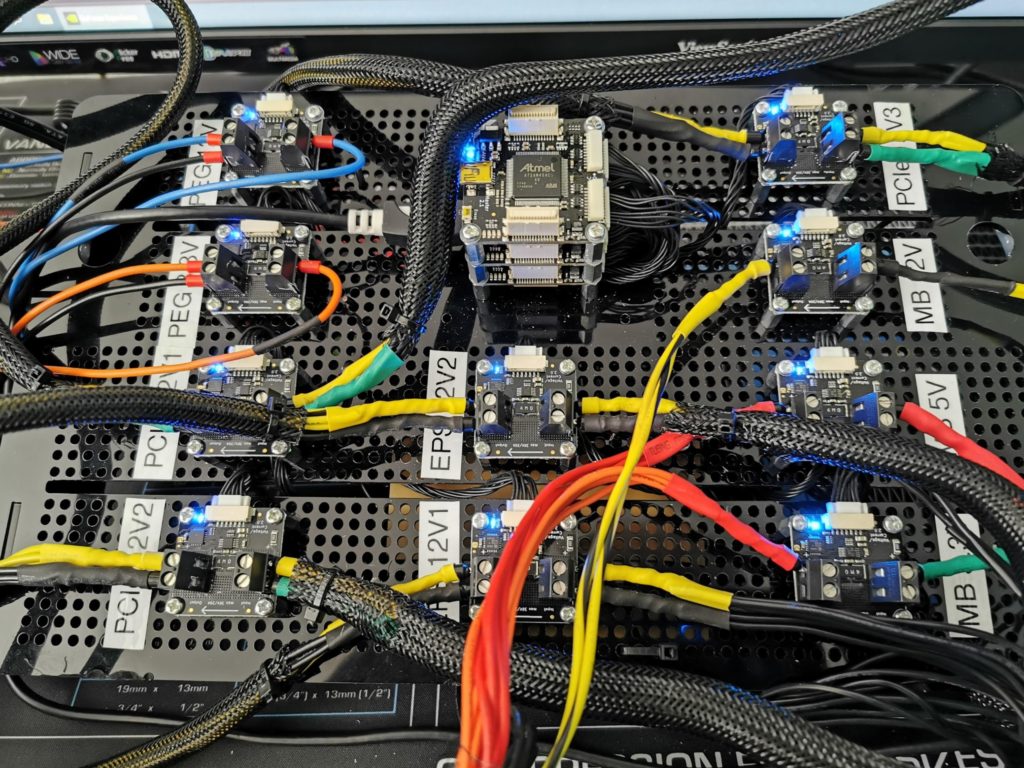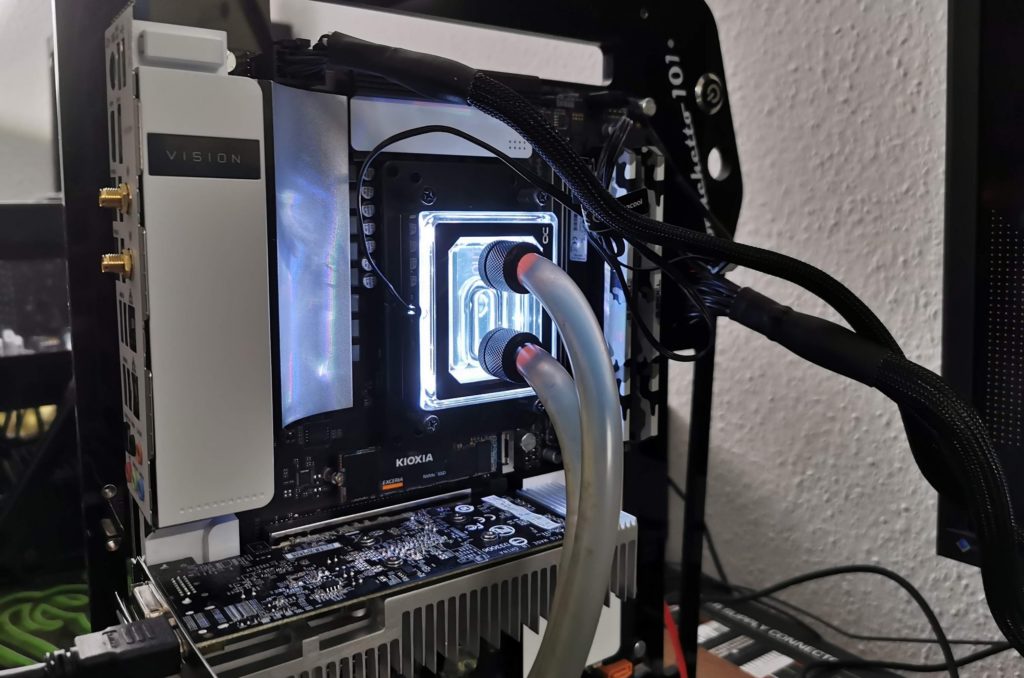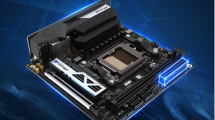For these tests I use generally known components whose power consumption values (e.g. RAM) are known, in order to be able to plausibly offset and check. The whole thing runs via a parallel measurement and acquisition of all voltage-carrying rails to the motherboard or the individual components with the help of my measurement setup. Shunts for up to 10 rails are used, the transmission of the measured values is done with time stamp via USB or Ethernet. The software used is a proprietary program and logging software from Powenetics.
Idle power consumption
Let’s start with the measurement in idle, RGB is off, all cores run at the lowest frequency. From the values of the 24-pin and EPS connectors I subtract the partial loads for the respective components, so that in the end you have an approximate value for the power consumption of the motherboard itself. But the measured values, especially for the CPU, are very interesting. If you do absolutely nothing, the network plug is pulled out and nothing else is running in the background, less than 10 watts for the CPU are now quite possible with the B550 chipset. But only then. Apart from that, the EPS alone is already around 19 to 22 watts for the CPU.
| Rail | Measured | Motherboard Net |
| Motherboard PCIe Slot 12 V | 8,6 W | |
| Motherboard PCIe Slot 3.3 V | 0.0 W | |
| Motherboard 24-Pin 12 V | 9.3 W | 0.7 W |
| Keyboard, Mouse | 0.7 W | |
| SSD |
1.5 W | |
| Motherboard 24-Pin 5 V | 11.8 W | 9.6 W |
| DRAM | 1.8 W | |
| Motherboard 24-Pin 3.3 V | 5.3 W | 3.5 W |
| CPU Package Power (Software) | 9.2 W | |
| EPS 8-Pin | 9.8 W | 0.6 W |
| Voltage transformer losses * |
1.5 W |
|
| Total | 15.9 W |
Power consumption 95 Watt Limit
Now let’s get to the increased load, but I deliberately capped the power consumption of the Ryzen 7 3800X to 95 watts. The real free ride is still to come, here we lie in the midfield for now.
| Rail | Measured | Motherboard Net |
| Motherboard PCIe Slot 12 V | 9.2 W | |
| Motherboard PCIe Slot 3.3 V | 0.0 W | |
| Motherboard 24-Pin 12 V | 9.7 W | 0.6 W |
| Keyboard, Mouse | 0.7 W | |
| SSD |
2.6 W | |
| Motherboard 24-Pin 5 V | 23.9 W | 20.6 W |
| DRAM | 5.4 W | |
| Motherboard 24-Pin 3.3 V | 9.4 W | 4.0 W |
| CPU Package Power (Software) | 95.1 W | |
| EPS 8-Pin |
97.4 W | 2.3 W |
| Voltage transformer losses * |
7.4 W | |
| Total | 34.9 W |
Power consumption 135 Watt maximum
With AVX in Prime, the board releases up to 133 watts on the package, as Precision Boost Overdrive <auto>is set</auto> to factory default. This is clearly above what AMD sets for the TDP with 105 watts. I am already using the Ryzen 9 3900X for this because it is more consistent and easier to produce than with a Ryzen 7 3800X overclocked up to both ears.
| Rail | Measured | Motherboard Net |
| Motherboard PCIe Slot 12 V | 9.3 W | |
| Motherboard PCIe Slot 3.3 V | 0.0 W | |
| Motherboard 24-Pin 12 V | 10.2 W | 0.9 W |
| Keyboard, Mouse | 0.7 W | |
| SSD |
2.8 W | |
| Motherboard 24-Pin 5 V | 25.5 W | 22.5 W |
| DRAM | 5.7 W | |
| Motherboard 24-Pin 3.3 V | 9.4 W | 3.7 W |
| CPU Package Power (Software) | 133.1 W | |
| EPS 8-pin + EPS 4-pin | 136.1 W | 2.0 W |
| Voltage transformer losses * |
11.4 W | |
| Total | 40.4 W |
But you have to pay attention to the values for Package-Power read out with HWInfo that the voltage transformer losses were NOT subtracted here! The software uses the IMON values reported back by the PWM controller. These losses should be around 5 to 8% of the package power values, depending on load and temperature. Since I did not physically modify this motherboard, this time I only have to estimate the values based on other partial measurements and readout values (*).
The fact is, and this is all the more astonishing because it is against all PR fairy tales, that the 12 voltage converter circuits on the 6 phases (2 converters per phase in parallel operation) do the same good job both in idle and under load as the 14 phases with one converter each on the Gigabyte B550 Aorus Master! We are talking here at the end about differences in the low watt range, which are only just above the measuring port lances.
GIGABYTE B550 Vision D
AMD Ryzen 5 3600X, 6C/12T, 3.80-4.40GHz, boxed (100-100000022BOX)
AMD Ryzen 7 3800X, 8C/16T, 3.90-4.50GHz, boxed (100-100000025BOX)
AMD Ryzen 9 3900X, 12C/24T, 3.80-4.60GHz, boxed (100-100000023BOX)

































Kommentieren